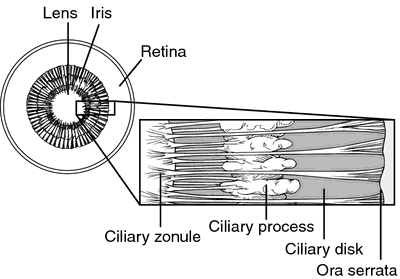zonule
[zōn´ūl]a small zone.
ciliary zonule (zonule of Zinn) a series of fibers connecting the ciliary body and lens of the eye, holding the lens in place.

Ciliary zonule. The system of suspensory ligaments holding the lens in position. From Dorland's, 2000.
Miller-Keane Encyclopedia and Dictionary of Medicine, Nursing, and Allied Health, Seventh Edition. © 2003 by Saunders, an imprint of Elsevier, Inc. All rights reserved.
Zinn, zonule of
A series of fibres passing from the ciliary body to the capsule of the lens at or near its equator, holding the lens in position and enabling the ciliary muscles to act upon it. The lens and zonule form a diaphragm that divides the eye into a small anterior area, which contains aqueous humour, and a larger posterior area, which contains vitreous humour. The zonule forms a ring that is roughly triangular in a meridional section. It is made up of fibres that are transparent and straight for the most part. The tension of these fibres varies with the state of contraction of the ciliary muscle and thus affects the convexity of the lens. The zonule of Zinn is made up of many non-cellular fibres, the fibrils of which consist of a cysteine-rich microfibrillar component of the elastic system, fibrillin. The fibres have been classified as follows: (1) The hyaloid zonule (orbiculo-posterior capsular fibres) which originate from the pars plana of the ciliary body and insert into the capsule just posterior to the equator at the edge of the patellar fossa. (2) The anterior zonule (orbiculo-anterior capsular fibres or anterior zonular sheet), which originate from the pars plana of the ciliary body and insert into the capsule just anterior to the equator. These are the strongest and thickest of the zonular fibres. (3) The posterior zonule (cilio-posterior capsular fibres or posterior zonular sheet), which originate from the pars plicata of the ciliary body and insert into the lens capsule posterior to the equator. These are the most numerous. (4) The equatorial zonule (cilio-equatorial fibres) which originate from the pars plicata of the ciliary body and insert into the lens capsule at the equator. Syn. suspensory apparatus of the lens; suspensory ligament; zonular fibres. See Hannover's canal; canal of Petit; ciliary processes; ora serrata.
Millodot: Dictionary of Optometry and Visual Science, 7th edition. © 2009 Butterworth-Heinemann